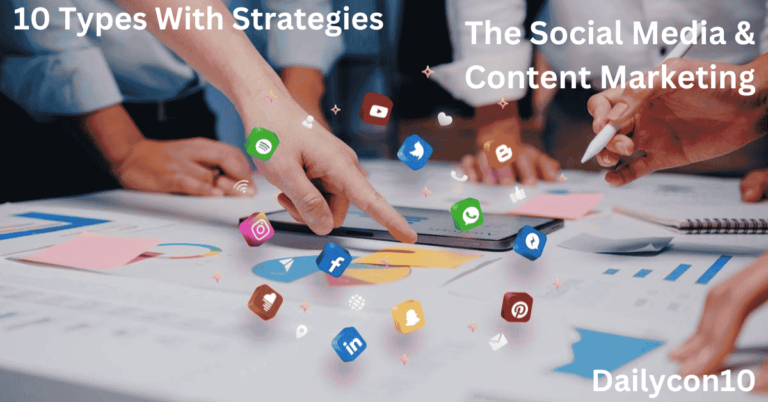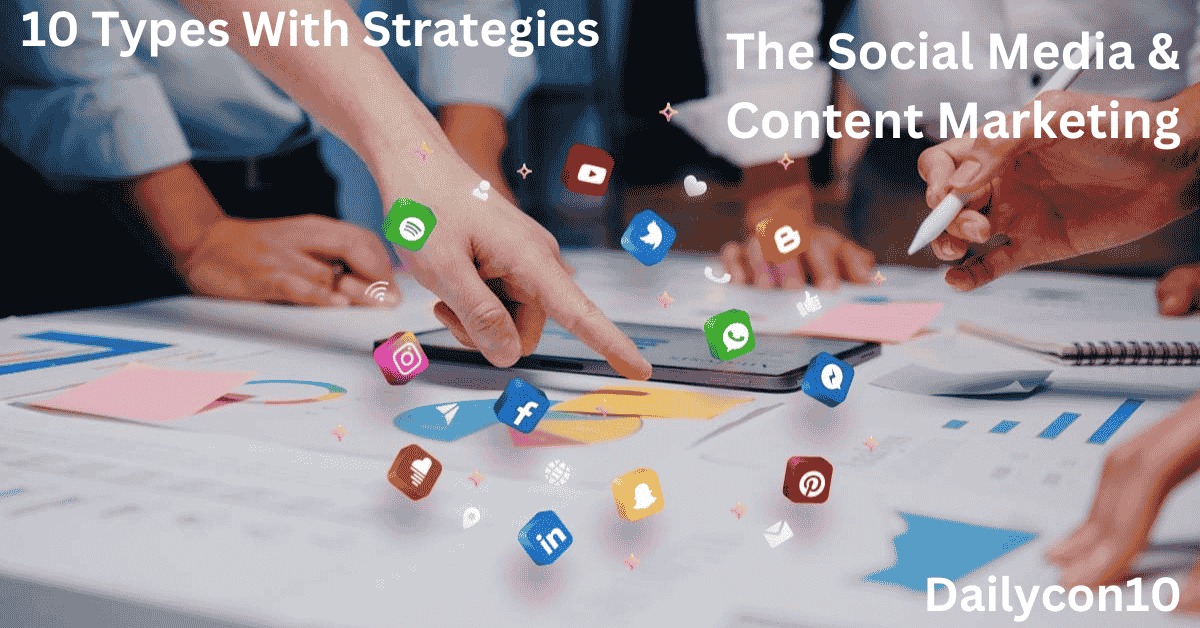Social media and content marketing have transformed the way businesses engage with their audiences. But what exactly do these buzzwords mean, and why are they crucial? If you’re a content creator or small business owner, this guide will walk you through the essentials of social media and content marketing, how they mesh together, and why mastering them can revolutionize your brand. .
By the end of this post, you’ll not only grasp how to wield these powerful tools to boost your online presence and connect with your target audience but also discover how to achieve impactful results.! 🚀
What is Social Media & Content Marketing? (SMM)
Definition and Importance
Social media marketing is all about harnessing platforms like Facebook, Instagram, and LinkedIn to skyrocket your business, connect with audiences, and build lasting relationships. Meanwhile, content marketing is the art of crafting and sharing valuable, relevant content that captivates, engages, and retains your target audience.
When these strategies join forces, they create an unstoppable synergy! Social media acts as the launchpad for your content, propelling it to the right audience. In turn, content marketing provides compelling stories and insights that fuel meaningful interactions on social platforms.
Picture content as the “what” and social media as the “where.” High-quality content gives folks a reason to follow, like, and engage with your brand. Social media ensures your captivating content lands in front of the right eye at the perfect moment. Together, they cultivate trust, nurture relationships, and ultimately drive sales.
Firstly Understanding Your Audience
Before diving into the world of social media and content marketing, it’s vital to truly know your target audience. Who are they? What are their interests? Where do they spend their time online? These are just a few of the compelling questions to explore when crafting your strategy.
To get an in-depth understanding of your audience, dive into market research and analyze your current customer base. This will provide valuable insights into their demographics, interests, and behavior patterns.
Once you’ve unlocked the secrets of your target audience, tailor your content and messaging to speak directly to their hearts. By addressing their needs and preferences, you’ll captivate their attention and build a loyal following eager to engage with your brand.
Knowing Your Audience Matters
Every audience is unique, with its preferences, needs, and challenges. Knowing your audience ensures that your content resonates and feels relevant. For instance, Gen Z might respond better to quick, trending content on TikTok, while LinkedIn professionals might prefer insightful, lengthy articles.
- Create Detailed Buyer Personas: Outline factors like age, location, income, interests, and online behavior.
- Use Analytics and Tools: Tools like Google Analytics, Facebook Insights, and Instagram Analytics can reveal demographic and behavioral data.
- Engage Your Followers Directly: Host polls, ask questions, and listen to feedback.
By putting your audience at the center of your content strategy, you set the stage for higher engagement and meaningful interactions.
Social Media Platforms & Their Benefits
Overview of Major Platforms
There are countless social media platforms out there, but not all are equally effective for every business.
- Facebook: Great for building community and running targeted ads thanks to its diverse user base.
- Instagram: Ideal for visually driven brands to showcase products, stories, and behind-the-scenes moments.
- Twitter: Perfect for real-time updates, thought leadership, and engaging in relevant trending topics.
- LinkedIn: The go-to platform for B2B businesses, professional networking, and industry insights.
What are the Types of Content Marketing?
Top 10 Types of Content Marketing (+ Tips for Success)
Here’s a deep dive into some of the most impactful forms of content marketing:
1. Blogging
Blogs are a classic yet powerful type of content marketing. They drive SEO through targeted keywords, provide value to readers, and position your brand as a thought leader in your industry.
Example: A personal finance company could share tips like “How to Save $500 in 30 Days” while targeting keywords their audience is searching for.
2. Social Media Content
With billions of active users across platforms like Instagram, Facebook, and LinkedIn, social media content lets businesses build communities and engage with their audience directly.
Types:
- Short-form videos (e.g., Reels, TikToks)
- Carousel-style posts
- Polls and user-generated challenges
- Interactive Q&A sessions
3. Video Marketing
Video marketing is exploding in popularity thanks to platforms like YouTube and the growing use of short-form videos. Videos allow you to tell stories and demonstrate products in a dynamic, engaging format.
- Tip: Focus on creating bite-sized, educational, or entertaining content to keep viewers engaged.
4. Email Marketing
Email content remains one of the most effective channels for driving engagement and conversions. You can use email newsletters, product updates, or drip campaigns to build a direct relationship with your audience.
Why It Works:
- It’s personal and targeted.
- It has superb ROI (estimates show $36 for every $1 spent).
5. Infographics
Infographics are a great way to present complex data or explain concepts visually. A well-designed infographic can be highly shareable, spreading your message across platforms.
6. Podcasts
Podcasting is fantastic for building a loyal audience. Cover niche topics in your industry, conduct interviews, or offer actionable tips and insights to become a go-to resource.
- Tip: Keep your episodes consistent in both content quality and release dates to maintain listener engagement.
7. Webinars
Webinars are interactive and educational, enabling businesses to connect with their audience on a more personal level. They’re perfect for product demonstrations, expert talks, or industry panel discussions.
8. Case Studies
Case studies showcase the real-world impact of your product or service. By telling a story of how you solved a problem for a specific customer, you build credibility and trust.
9. User-Generated Content (UGC)
UGC includes anything created by your customers, such as reviews, social media posts, or testimonials. This type of content can be highly persuasive, as it reflects genuine experiences with your brand.
10. White Papers and eBooks
These in-depth resources are excellent for sharing thought leadership and technical knowledge. They’re perfect for lead generation, as you can offer them in exchange for contact information.
“Pro Tip”: Remember to balance automation with personalization—respond to comments and engage directly with followers.
Key Metrics to Track
- Engagement Rate (likes, comments, shares): Measures how much your audience interacts with your posts.
- Click-Through Rate (CTR): Tracks how often people visit your linked pages.
- Follower Growth and Reach: Monitors how effectively you’re expanding your audience.
- Conversions (sales, sign-ups): The ultimate measure of ROI for your efforts.
How to Choose the Right Type of Content Marketing
Selecting the best type of content marketing for your needs depends on the following factors:
- Know Your Audience: What platforms do they use the most? What formats resonate with them (e.g., videos, articles, or podcasts)?
- Understand Your Strengths: Are you a skilled writer, video editor, or speaker? Choose formats where you can shine.
- Define Your Goals: Want to boost engagement? Social media and live streams might be your go-to. Looking to build long-term SEO traffic? Focus on blogging.
By aligning your content marketing strategies with these elements, you can maximize your impact.
Tips for Effective Content Creation and Distribution
Creating content doesn’t stop at production—distribution is equally critical.
- Repurpose Content: Turn a blog post into a podcast episode or an infographic to reach a wider audience.
- Engage With Your Community: Respond to comments and DMs to build relationships with your audience.
- Collaborate: Partner with other creators or brands for co-marketing opportunities.
Measuring the Success of Your Content Marketing Efforts
To understand what’s working, use metrics that align with your objectives:
- Engagement Metrics (likes, shares, comments) for brand awareness and interaction.
- Conversion Metrics (click-through rates, email sign-ups) for lead generation.
- Traffic Metrics (page views, bounce rates) for evaluating SEO performance.
What is the difference between social marketing and content marketing?
Marketing in the digital age has unlocked endless opportunities for businesses and content creators. Yet, with countless strategies at your fingertips, it’s easy to feel overwhelmed. Two standout—but often misunderstood—approaches are social marketing and content marketing. Both are crucial for building brand awareness, connecting with audiences, and achieving business goals, yet each takes a unique path to success.
Grasping the distinction between these two can refine your marketing strategy, optimize resource allocation, and—most importantly—propel you toward success. Dive into this blog as we unravel what sets social marketing apart from content marketing, explore their intersections, and guide you in choosing the best approach for your needs.
Successful Social Marketing Campaigns
- “Share a Coke” Campaign (Coca-Cola)
Coca-Cola personalized bottles with popular first names and encouraged users to share photos on social media.
- Spotify Wrapped
Spotify’s annual “Wrapped” feature allows users to share personalized summaries of their listening habits, sparking both individual pride and mass peer interaction.
Tools and Resources for Content Creation and Management
Streamline your content with these tools:
- Content Planning: Trello, Notion
- Graphics: Canva, Adobe Creative Cloud
- Video Editing: CapCut, Adobe Premiere Pro
- Writing/Editing: Grammarly, Jasper
- Analytics: Google Analytics, SEMrush, BuzzSumo
Conclusion:
A diverse range of topics, optimized for search engines, can draw in organic traffic. Blogs also invite audience interaction through comments and social sharing, creating a vibrant community and boosting engagement. For content creators, blogs are a powerful tool to establish authority in your niche and drive traffic to your website. Dive into blogging and watch your influence grow!


